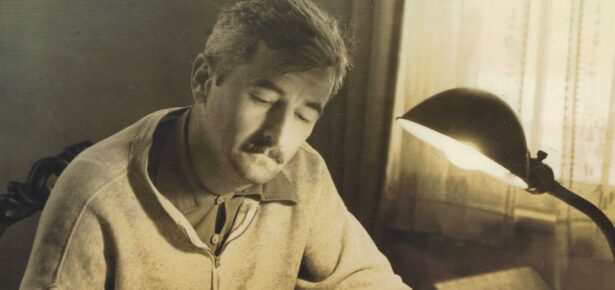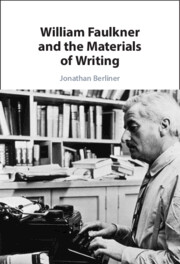
William Faulkner at his home in Oxford, Mississippi, ca. 1932
In 2016, a handmade booklet of drawings and poems turned up on an episode of Antiques Roadshow from Little Rock, Arkansas. The man who owned the piece described it as “a book of poems by William Faulkner,” and appraiser Ian Ehling, now Director of Fine Books and Manuscripts for Bonhams New York, confirmed its authenticity. The owner explained that it was a gift from Faulkner to a family friend who died in the 1980s and had briefly dated the author around 1920. Indeed, Faulkner during this time made several such books in the art nouveau style of this volume with ornate lettering and pen and ink illustrations of flappers and other characters. He bound these himself and gave them to friends and potential girlfriends, one of whom became his wife, though they had known each other from childhood. Faulkner titled the volume featured on Antiques Roadshow, Chansons au printemps.
Faulkner’s mother taught him to draw at an early age, and he made sketches in notebooks and composed other illustrations. While spending time at the University of Mississippi, he produced the manuscript for a one-act play called The Marionettes as much dramatic verse as visual arts piece with drawings and elegant writing throughout. In 1929, Faulkner expressed interest in printing the opening section of The Sound and the Fury in several different colors to show transitions in the thoughts of the mentally disabled character Benjy Compson whose internal voice Faulkner narrates as a stream of consciousness. This was too expensive at the time, though, especially for a relatively unknown author, and the publisher used black ink and the italics Faulkner had originally indicated in the manuscript.
Faulkner later worked in Hollywood and contributed to scripts for films that have become classics, including Mildred Pierce (1945) and The Big Sleep (1946), but his most influential contribution to the arts in the twentieth century remains his prose fiction so thick with shades of meaning and verbal play that he marveled near the end of his life he had been able to write such works at all. These novels and short stories also contain a good deal of play with materials of writing used by his characters and narrators from old paper to tattered books, mimeograph machines to American Indian writing sticks. Faulkner may well have sublimated his interest in the visual arts such that texts in his works repeatedly become material objects.
One of the most surprising things we discover when reading Faulkner in this manner is how he turns race and gender into media phenomena. Faulkner’s 1932 novel Light in August depicts a racially ambiguous character named Joe Christmas whose face the narrator describes as parchment. Although this may be a way to convey his skin tone, it becomes a surface inscribing race onto his body. In his 1931 novel Sanctuary, the narrator describes his central character, a woman named Temple Drake, as having inkwell eyes. Men then extract what they suppose to be feminine ink and project this misogynistically back onto her body.
Context matters a great deal, however, when examining Faulkner’s use of material texts in his work. His books Intruder in the Dust (1948) and Requiem for a Nun (1951) revisit these earlier novels implicitly in the former case and explicitly in the latter. When a vigilante mob comes to lynch a Black character in Intruder in the Dust held in the town jail who the townspeople think killed a white man, the narrator describes the person guarding the door to the building as an expert marksman, yet he holds not a gun but color newspaper comics, which reflect back to the mob their own foolishness, and they soon return home. While things go poorly for Temple in Requiem for a Nun, she describes herself as a good writer of explicit letters, which gestures toward empowering female authors to compose works with a more frank sexuality.
In many ways, Faulkner’s most tender use of writing materials can be found in his late novel The Mansion (1959) where two characters, Gavin Stevens and Linda Snopes Kohl, communicate on an ivory tablet with a matching gold stylus because Linda has lost her hearing while fighting in the Spanish Civil War. They never consummate their relationship sexually, and critics have long understood their connection as platonic. Yet their relationship becomes physical with the tablet a prosthetic extension of their bodies. Partway through the book, Gavin visits Linda in Pascagoula, Mississippi, where she works as a shipyard riveter during the Second World War. Her lack of hearing becomes an advantage in this situation. Linda rents two rooms for them at a hotel with only a thin wall separating them. They say they love each other, but Linda has Gavin put this on the tablet so she can awaken the next morning to these words.
We write things down to remind ourselves of tasks to accomplish and can treasure a note from a friend. The larger point we might take from Faulkner involves the ways material texts enter our lives. Sometimes they connect bodies with virulent ideologies. But they can also deflect aggression and enact a kind of love with shared intimacy.

William Faulkner and the
Materials of Writing
by Jonathan Berliner
Latest Comments
Have your say!